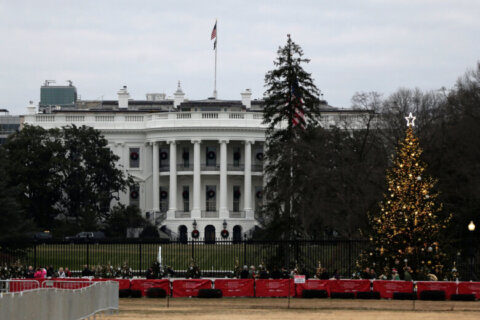This video is no longer available.
Anyone who steps outside in the morning can tell that fall is in full swing and winter is on the way. While the D.C. area saw some snowstorms last year, there are no promises it’ll happen again this year.
Forecasters with the National Oceanic and Atmospheric Administration (NOAA) are blaming it all on La Nina, which sees stronger than normal trade winds blowing warmer water on the surface of the ocean, west toward Asia. That leaves a mass of colder than usual water in the central Pacific Ocean, pushing the jet stream further to the north. For us, that usually means less snow.
“For the mid-Atlantic region, or greater D.C. area, we are favoring above normal temperatures along the Eastern Seaboard, including the D.C. metro area,” said Jon Gottschalck, senior forecaster with NOAA.
When La Nina pushes the jet stream to the north, it means most of our weather comes directly from the west, and so higher amounts of precipitation are in the forecast for the more mountainous parts of the region west of D.C. and beyond into the Ohio Valley.
“One thing that’s often the case with La Nina … is that, typically, with the warmer conditions and a more storm track to the west, there typically is less snowfall in the mid-Atlantic region,” said Gottschalck.
He’s predicting a lot of snow around the Great Lakes and the Northern Plains of the U.S. The lakes effect snow in the earlier parts of the winter, when they are warmer and can supply a lot of moisture. Colder spells later in the winter keep the snow chances going.
Normally, the really big snowstorms that hit the D.C. region come when the jet stream dips to the south and pulls up moisture from the ocean into the area. Last year, when the D.C. area finally got snow again, the Pacific Ocean was seeing a strong El Niño, which is the opposite of La Nina.
The current predictions also tend to not favor much in the way of the so-called “Polar Vortex” around here — those long stretches of dangerously cold weather when air masses from Canada settle over us.
If you’re a snow lover disappointed by all this, it should also be noted that NOAA expects this winter’s La Nina to be on the weaker side of things, so forecasters also aren’t nearly as certain things will play out this way.
“The winter outlook is probabilistic in nature,” noted Gottschalck. “However, the nature of a probabilistic forecast means that other outcomes are always possible. Though they are less likely. In fact, for our probabilities to be consistent with the nature of this outlook, that less likely outcome must occur from time to time.”
The odds are also evenly split between a wetter than normal winter, a normal winter or a dryer than usual winter for the D.C. region — so a snowstorm is still a possibility, even if it’s less likely to occur.
“There is a dry signal for less snowfall in that region,” Gottschalck said. “But there’s more uncertainty given the weaker La Nina. So generally warmer, kind of uncertain with precipitation, potentially less snowfall this year for the D.C. area.”
Get breaking news and daily headlines delivered to your email inbox by signing up here.
© 2024 WTOP. All Rights Reserved. This website is not intended for users located within the European Economic Area.








